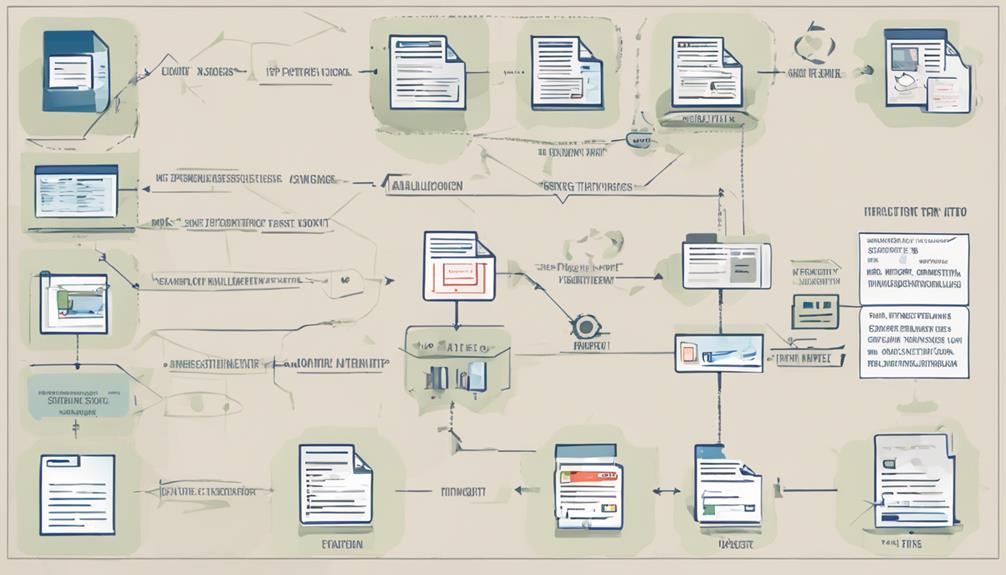Have you ever wondered about the essential components that make up SGML conversion services? Understanding SGML conversion services and the intricacies of this process involves delving into key aspects such as the benefits, steps, software options, outsourcing considerations, best practices, significance of SGML in data conversion, and challenges faced. Each of these elements plays a crucial role in ensuring a successful SGML conversion, but there is one aspect that stands out as particularly critical.
Benefits of SGML Conversion
Are you considering SGML conversion services? Making the switch can lead to significant cost savings and improved efficiency for your organization. By converting your documents to SGML format, you streamline the process of managing and accessing large volumes of structured data. This can result in reduced production costs and faster retrieval times, ultimately saving you time and money in the long run.
SGML conversion services enable you to standardize your document structure, making it easier to search, update, and repurpose content. This standardization not only enhances the overall quality of your documents but also improves collaboration among team members. With SGML, you can ensure consistency across all your content, leading to a more professional and polished final product.
In addition to these benefits, SGML conversion services can also help future-proof your documents, ensuring they remain accessible and usable for years to come. By investing in SGML conversion now, you are setting your organization up for success in the ever-evolving digital landscape.
Steps in SGML Conversion
Now let’s explore the essential steps involved in SGML conversion. You will learn about the conversion process overview and the tools and techniques utilized in this intricate process. Understanding these key points will help you grasp the intricacies of SGML conversion services.
Conversion Process Overview
To understand the SGML conversion process, it is crucial to grasp the sequential steps involved in transforming documents into SGML format. The conversion process begins with analyzing the existing data structure of the documents. This step is essential to identify the elements, attributes, and relationships within the content. Once the data structure is understood, the next step involves defining the appropriate markup language. This is where the specific tags and attributes that will be used to represent the document’s structure are determined.
After defining the markup language, the actual conversion process takes place. During this stage, the documents are parsed and transformed into SGML format according to the predefined rules. This involves adding the necessary tags, attributes, and other structural elements to ensure that the document conforms to the SGML standards. Finally, the converted documents are validated to ensure that they are compliant with the SGML specifications and ready for use in SGML-based systems. Understanding these steps is crucial for a successful SGML conversion process.
Tools and Techniques
How can you efficiently navigate the SGML conversion process through the utilization of various tools and techniques? When undertaking SGML conversion, employing the right conversion tools and techniques is crucial for a successful outcome. Conversion tools like OmniMark, Author-it, or Xeditor can streamline the process by automating tasks and ensuring accuracy. Techniques such as document analysis, tag mapping, and quality assurance checks play a significant role in maintaining data integrity throughout the conversion process.
In addition to conversion tools, implementing formatting solutions and strategies is essential for preserving the structure and layout of the content. Utilizing style sheets, templates, and markup languages like HTML or XML can help in achieving consistent formatting across different platforms. By incorporating these formatting solutions and strategies, you can ensure that the converted SGML documents retain their original look and feel while being compatible with modern systems and devices.
SGML Conversion Software
When considering SGML conversion services, the role of SGML conversion software is pivotal in efficiently transforming SGML documents into various formats. SGML conversion software offers a range of features that enable seamless conversion, such as batch processing capabilities, customizable tagging options, and support for complex document structures.
One key aspect to consider when evaluating SGML conversion software is the cost analysis. Different software providers may offer varying pricing models, including one-time purchases, subscription-based plans, or pay-per-use options. It is important to assess the cost implications based on your specific needs and budget constraints. Additionally, consider the level of technical support provided by the software vendor, as reliable support can significantly impact the efficiency of the conversion process.
Before selecting an SGML conversion software, thoroughly evaluate the software features, conduct a cost analysis, and ensure that the software aligns with your requirements for converting SGML documents effectively and efficiently.
Outsourcing SGML Conversion Services
Considering the complexities and resource-intensive nature of SGML conversion, outsourcing SGML conversion services can provide a strategic solution for organizations looking to streamline their document transformation processes. By outsourcing, you can benefit from cost effectiveness and ensure quality assurance in the conversion of your documents. Outsourcing SGML conversion services allows you to leverage the expertise and specialized tools of professional service providers, saving your organization time and resources. These services typically have quality control measures in place to ensure accurate and consistent conversion results. Additionally, outsourcing can help you avoid the need to invest in expensive software or train internal staff, further enhancing cost effectiveness. Partnering with a reliable SGML conversion service provider can also offer scalability, allowing you to adjust resources based on your current needs. Ultimately, outsourcing SGML conversion services can lead to more efficient document management processes while maintaining high standards of quality.
Best Practices in SGML Conversion
To ensure successful SGML conversion, implementing best practices is essential. When it comes to SGML conversion, following effective strategies and maintaining stringent quality control measures are crucial. Here are some key best practices to consider:
- Thoroughly Analyze Source Data: Conduct a detailed analysis of the source SGML files to understand the structure and content before beginning the conversion process.
- Define Clear Conversion Objectives: Clearly outline the goals and requirements of the SGML conversion to ensure the end result meets the desired specifications.
- Utilize Automation Tools: Implement automation tools and software to streamline the conversion process, improve efficiency, and reduce manual errors.
- Regular Quality Checks: Establish a robust quality control process to continuously monitor the conversion progress and address any issues promptly.
- Document Conversion Procedures: Document the conversion procedures and guidelines followed to maintain consistency and facilitate future reference.
Role of SGML in Data Conversion
SGML plays a pivotal role in data conversion processes, serving as a structured markup language that enables efficient transformation of content from one format to another. Its emphasis on data organization ensures that information is structured in a standardized manner, facilitating seamless conversion between different file types. By defining the document structure, SGML allows for the categorization and labeling of content elements, making it easier to identify and manipulate data during the conversion process. This level of standardization not only streamlines the conversion workflow but also enhances the overall efficiency of the operation. The structured nature of SGML enables converters to map out how each piece of information should be handled, reducing errors and improving the accuracy of the final output. Therefore, when engaging in data conversion tasks, leveraging SGML can significantly enhance the organization, efficiency, and standardization of the process.
Challenges in SGML Conversion
As you navigate the realm of SGML conversion, you are likely to encounter various challenges that can impact the efficiency and accuracy of the process. Ensuring data accuracy and maintaining the integrity of the file structure are crucial aspects that can pose significant obstacles during SGML conversion. Here are five key challenges to be aware of:
- Complex Formatting: SGML documents often contain intricate formatting requirements that can be challenging to replicate accurately during the conversion process.
- Legacy Systems Compatibility: Integrating SGML data with modern systems while preserving its original structure can be difficult due to compatibility issues.
- Metadata Preservation: Maintaining metadata integrity throughout the conversion is essential for ensuring data accuracy and completeness.
- Quality Control: Verifying the accuracy of the converted data against the original SGML documents requires meticulous quality control measures.
- Large Volume Processing: Handling large volumes of SGML data for conversion without compromising data accuracy or file structure can be a significant challenge.
Frequently Asked Questions
Are There Any Specific Industries That Benefit Most From SGML Conversion Services?
In industries like aerospace, automotive, and manufacturing, SGML conversion services offer clarity and efficiency. Companies in these sectors benefit most due to complex technical documentation needs. The SGML conversion timeline streamlines processes and promotes accuracy.
How Long Does It Typically Take to Complete an SGML Conversion Project?
Typically, an SGML conversion project takes around 2-4 weeks to complete. The project timeline may vary based on the complexity of the documents and your specific requirements. Manage your completion expectations accordingly for smoother results.
Can SGML Conversion Services Handle Large Volumes of Data Effectively?
Sure thing! Scaling data and ensuring efficiency in SGML conversion services is crucial for timely project completion. With a robust system in place, handling large volumes of data becomes a seamless process, guaranteeing efficient outcomes.
Are There Any Potential Risks or Drawbacks Associated With Outsourcing SGML Conversion?
When outsourcing SGML conversion, risks and drawbacks may include data security concerns, potential loss of control over the process, and limitations in customization. It’s essential to carefully assess these factors before making a decision.
What Are the Key Factors to Consider When Choosing SGML Conversion Software?
When choosing SGML conversion software, consider software compatibility for seamless integration, cost effectiveness for budget efficiency, accuracy for precise results, and robust customer support for assistance. Evaluate these factors to make an informed decision.



